
By Olivia McDaniel, Archaeologist - Lighthouse Archaeological Maritime Program
August 14, 2014
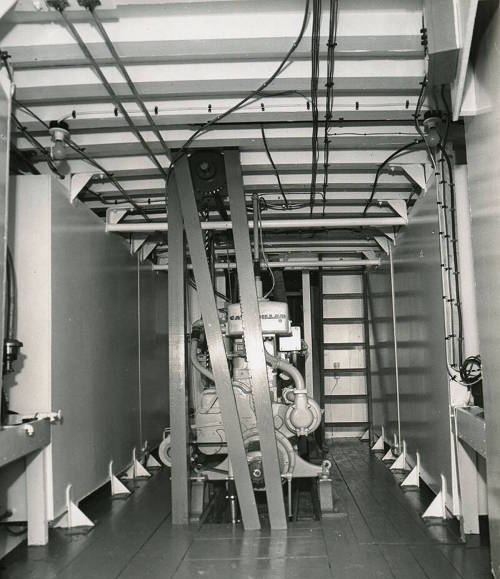
Here we see an example of what the fuel tank from target E3T may have looked like. This is the engine room of the shrimp boat Captain Frisky in 1961. It has four fuel tanks, two on each side. Note the elbow brackets on the top and bottom of the tanks. One of these ripping away from the tank in a wrecking event may have caused the hole visible on the tank from target E3T. Image courtesy of Image courtesy of the Search for the Lost French Fleet of 1565 Expedition, NOAA-OER/St. Augustine Lighthouse & Museum. Download larger version (jpg, 452 KB).
Yesterday’s concretion has inspired a certain excitement aboard the Roper this morning as we prepare for the day’s diving operations. The first concretion confirming the presence of cultural material on a target is exciting in any circumstance, but none of us can help but hope that this concretion will help reveal a 450-year-old French shipwreck.
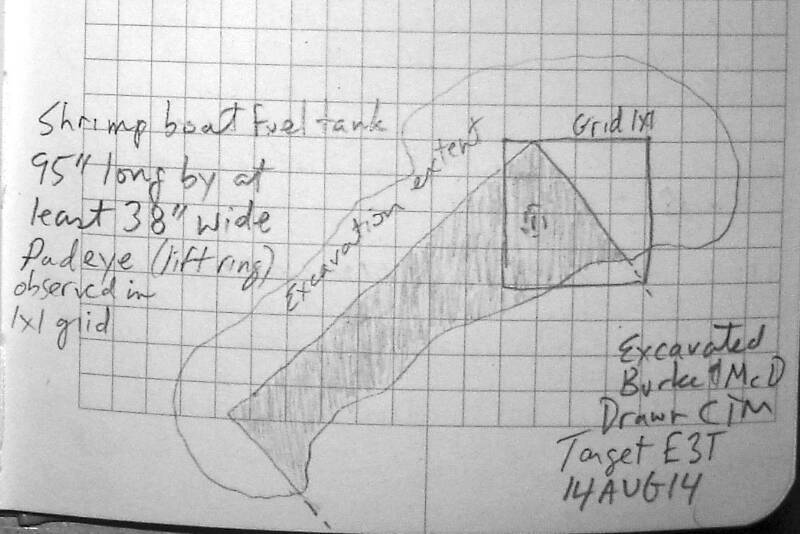
A sketch of the object discovered at Target E3T, identified as a steel fuel tank from a shrimp boat. Image courtesy of Image courtesy of the Search for the Lost French Fleet of 1565 Expedition, NOAA-OER/St. Augustine Lighthouse & Museum. Download larger version (jpg, 153 KB).
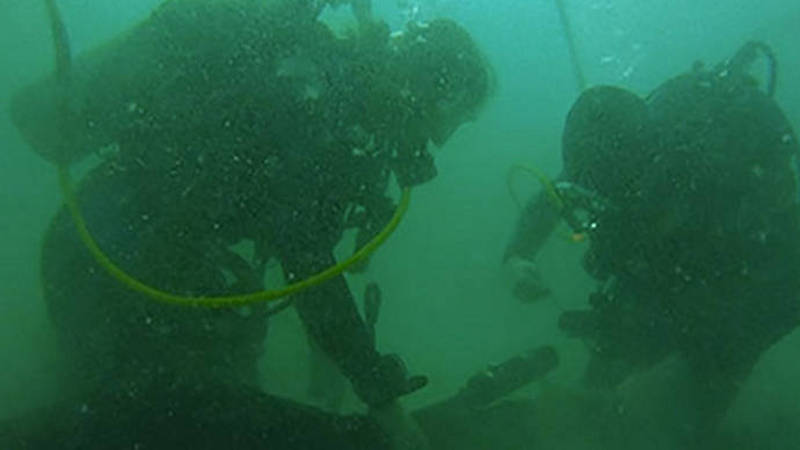
The excavation process from set-up to the beginning stages of excavation. Image courtesy of Image courtesy of the Search for the Lost French Fleet of 1565 Expedition, NOAA-OER/St. Augustine Lighthouse & Museum. Download image (jpg, 25 KB). Watch the video.
The first step in discovering the nature of this concretion is to prepare the area for excavation. While it is possible to blast sand away with the probe, to enact a controlled excavation means a handheld dredge must be used to carefully and systematically remove sand from around they unknown buried object. This would be much safer for any delicate archaeological remains than if we were to simply use the hydraulic probe to blast sand away.
After assembling the dredge hose, Brenden and I dive to secure the dredge to the sea floor, place a one meter by one meter excavation grid over the probe hole where Starr and I discovered the concretion last night. We then begin excavating to uncover the concretion.
If it is small enough, the concretion can be transported back to port, where x-rays will be taken to determine the contents of the concretion, and possibly give us clues as to what time period this object came from.
During the excavation, we quickly realize that this concretion is much larger than we anticipated. After approximately 30 minutes of excavation, we have uncovered enough of the concretion to see that it extends beyond the grid. Further excavation reveals that the concretion is a large box, approximately 95 inches long by 38 inches wide. We were unable to dredge deep enough to determine the height of the box.
At this point, we are certain that this concretion is from the recent past, rather than centuries old. Brendan, who is our resident expert in the shrimping industry—he literally "wrote the book" on shrimping and shrimp boat building , believes the concretion is a fuel tank from a shrimp boat wreck, possibly World War II era or later.
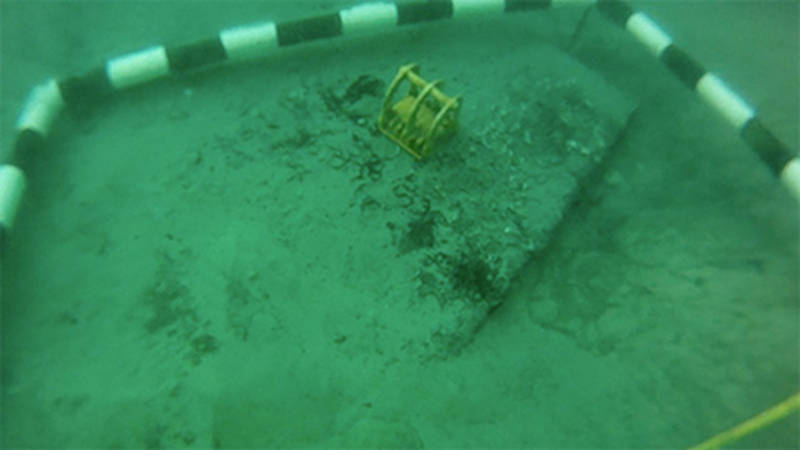
Brendan Burke and Olivia McDaniel excavate the concretion found yesterday, exposing what is most likely a fuel tank from a shrimp boat wreck dating to the WWII era or later. Image courtesy of Image courtesy of the Search for the Lost French Fleet of 1565 Expedition, NOAA-OER/St. Augustine Lighthouse & Museum. Download image (jpg, 29 KB). Watch the video.
The second video shows the end of our excavation and some of the concretion’s defining features. The square corners are easily visible at different points in the video. The yellow object in the beginning of the video is a magnet, used to test the magnetic properties of the concretion. Next to the magnet is what we believe is a padeye, which is a lifting harness used on shrimp boat fuel tanks. The hole to the right of one of the corners is in the right location for an elbow bracket that would have helped secure a fuel tank within a shrimp boat’s engine room. In a wrecking event, that bracket could have easily broken away from the tank, accounting for the hole in our concretion.
By the end of the video you can see the divers using the dredge to expose the far corner of the steel box, so that we can record a measurement of its total length.
Naturally, we are all a bit disappointed that our mystery concretion is unrelated to Ribault’s ships. However, we are still able to add the location of newly found wreckage to the archaeological record, and we still have untested targets that could hold part of Ribault’s fleet.
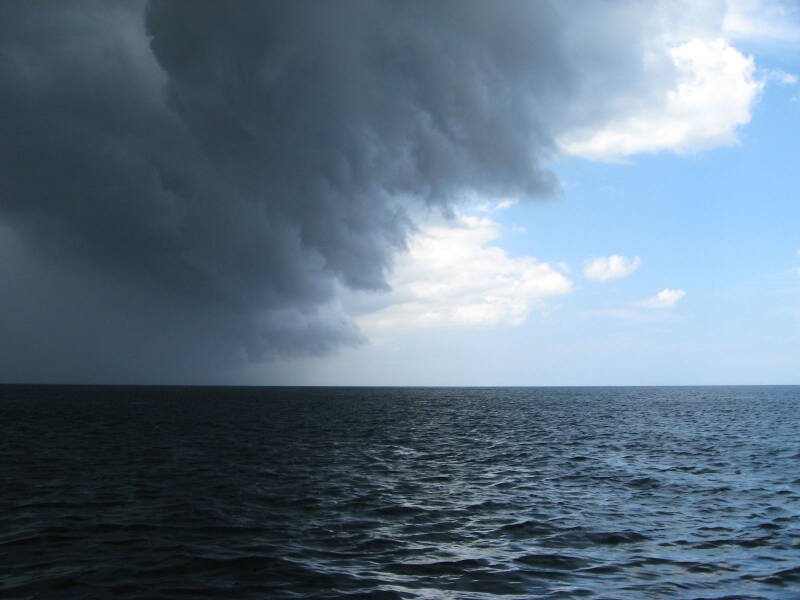
The lightning and rougher seas this storm brought with it delayed our dive operations on the new target until approximately 1800 hours this evening. Image courtesy of Image courtesy of the Search for the Lost French Fleet of 1565 Expedition, NOAA-OER/St. Augustine Lighthouse & Museum. Download larger version (jpg, 223 KB).
So, we decide to move on to one of those untested targets. By 1300 hours, we are underway. After waiting out some inclement weather this afternoon, we arrive and anchor at target E4T at 1800 hours.
Chuck and Brendan dive to begin the test probes, finishing both the North/South and East/West lines during their dive. Unfortunately, this dive reveals no positive returns. At this point, it is too late and we are all too tired to continue diving, so we start making plans to continue testing this target tomorrow.